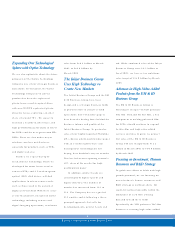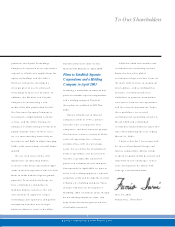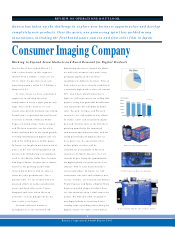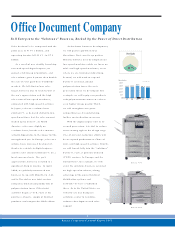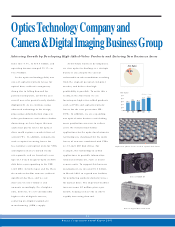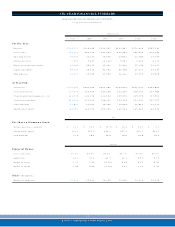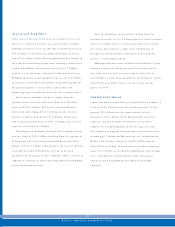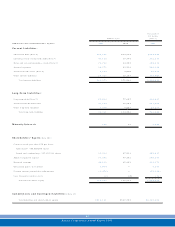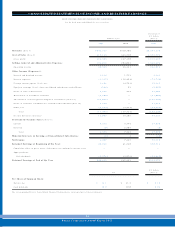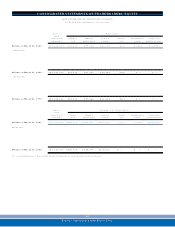Konica Minolta 2001 Annual Report Download - page 18
Download and view the complete annual report
Please find page 18 of the 2001 Konica Minolta annual report below. You can navigate through the pages in the report by either clicking on the pages listed below, or by using the keyword search tool below to find specific information within the annual report.
Konica Corporation/ Annual Report 200 1
16
CONSOLIDATED FINANCIAL REVIEW
Sales Results
In the fiscal year ended March 31 , 2 0 0 1, consolidated net
sales totaled ¥ 5 4 3 .7 billion, a dec line of 3 .1 % from the
previous fiscal year. The world ec onomy experienced a
relatively positive trend during the first part of the fiscal year.
Beginning in autumn 2 0 00 , however, the outlook became
much cloudier as information technology ( IT) -related
industries centered on the United States, which had helped
drive the ec onomy, entered an adjustment phase. In Japan,
an inc rease in c apital investment from the private sector
sparked hopes of at least a slight recovery, but continued
stagnation in consumer spending and flat stock prices in the
latter half of the year led to continued pessimism about the
overall economy.
Unfavorable c urrency exchange fluctuation also served to
dampen Japan’s economy. The yen appreciated 3 .9% against
the U.S. dollar during the fiscal year, to an average of
¥ 1 0 8 .83 in March 20 0 1 , and 1 6 .5 % against the euro, to
an average of ¥ 9 9 .9 4 in March 20 0 1 . This had a signific ant
impact on sales, contributing to a drop of ¥2 5.3 billion.
Looking at results in our photographic materials
segment, sales increased for the Medical and Graphic
Company owing to rapidly growing demand for dry films
for X-ray imaging systems. In the EM & ID Business Group,
demand continued to develop for our triacetyl cellulose
( TAC) film, used for the polarizing filters in liquid crystal
displays ( LCDs) . Demand continued to climb in the Inkjet
Business Group as well, where we enjoy an outstanding
reputation for quic k-drying, photo-quality paper.
Nevertheless, sales by the Consumer Imaging Company were
affec ted by price declines and the graphic imaging segment
remained in an economic slump, and both segments
experienced a decrease. In particular, the consumer
imaging segment was affected by the yen’s appreciation,
falling ¥9 .4 billion, and as a result sales dropped ¥ 1 8 .7
billion.
In our business machines segment, the Optics
Tec hnology Company posted higher sales reflecting double-
digit growth in sales of aspherical plastic lenses for use in
optical disc s. For the Office Doc ument Company, however,
sales on a volume basis inc reased reflecting the completion
of our lineup of digital copiers, but the yen’s appreciation
led to a ¥ 1 3 .8 billion drop in terms of sales amount. As a
result, sales for these operations were down ¥ 7 .0 billion
compared with the previous fiscal year.
Cost of Sales, and Selling and General
Administrative Ex penses
The cost of sales during the fisc al year under review fell
1 .4% compared with the previous period, to ¥3 19 .2 billion,
due to purc hasing costs, resulting from the changes in the
currenc y exc hange rate and to the Company' s cost-reduc tion
efforts. However, due to lower sales and to price revisions,
the cost of sales ratio increased one percentage point, from
5 7 .7 % to 5 8 .7 %. As a result, gross profit declined 5 .3 %
from the previous year, to ¥ 2 2 4 .6 billion.
Selling and general administrative expenses decreased
¥ 1 0 .0 billion from the previous year, to ¥1 9 4 .0 billion, a
drop of 4 .9 %. However, bec ause net sales also fell 3.1 %, the
SG&A expenses ratio was down only 0 .7 percentage point
from the previous year, from 3 6 .4 % to 35 .7 %. The main
fac tors behind the decrease included efforts to streamline
operations, such as c utbacks in labor and incentives
centering on the Consumer Imaging Company. R&D
alloc ations were focused in three strategic areas: optics
technology, medical imaging, and inkjet technology.


